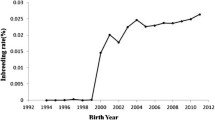Abstract
Small Tail Han (STH) sheep is a famous Chinese local breed and has perfect prolificacy performance, but it is inferior to imported mutton sheep breeds on meat production. In this study, six imported male sheep populations (White Suffolk, Black Suffolk, Texel, Dorper, South African Mutton Merino and East Friesian) were crossbred with STH female sheep respectively. The heterosis values of litter size, average daily gain (ADG) and feed conversion ratio (FCR) of crossbred sheep were analyzed for seeking the optimal cross. Meanwhile 28 microsatellite markers were used to measure the genetic distance between imported populations and STH population. Regression between the genetic distance and heterosis was analyzed for evaluating potential of microsatellite on predicting heterosis. Results showed a significant positive linear correlation (r = 0.892, P < 0.05) between heterosis of litter size and genetic distance D A of six crosses. This implied that these microsatellite markers had moderate potential to forecast heterosis of litter size in sheep. Results of this study also indicated that South African Mutton Merino and East Friesian sheep would be the optimal sire breeds for the litter size and might bring the greatest economic benefit in six imported populations; Suffolk sheep could be prior consideration as sire breeds when breeding objective focused on ADG. Finally these results provided valuable information for Chinese sheep industry.

Similar content being viewed by others
References
Tu YR (1989) The sheep and goat breeds in China. Shanghai Science and Technology Press, Shanghai, p 51
Falconer DS, Mackay TFC (1996) Introduction to quantitative genetics, 4th edn. Addison Wesley Longman, Essex
Ponsuksili S, Wimmers K, Schmoll F, Horst P, Schellander K (1999) Comparison of multilocus DNA fingerprints and microsatellites in an estimate of genetic distance in chicken. J Hered 90:656–659
Kozhukhova NE, Varenik BF, Sivolap IuM (2005) Predictive potential of DNA markers in heterosis breeding of maize. Tsitol Genet 39(1):14–20
Balestre M, Von Pinho RG, Souza JC, Oliveira RL (2009) Potential use of molecular markers for prediction of genotypic values in hybrid maize performance. Genet Mol Res 8(4):1292–1306
Zhang YJ, Zhao YZ, Liu YQ, Li Y, Sun SH, Xing HX (2004) Genetic polymorphism of four microsatellites DNA in three goat populations and relationship with heterosis. Hereditas (Beijing) 26(5):631–636 (in Chinese)
Sun SH, Sang RZ, Shi SK, Jia Q, Li YQ, Li XM, Tian SJ, Gao JS, Yan GZ, Ding YC, Huang YX (2000) Prediction and evaluation of heterosis of beef cattle and their application. J Genet Genom 27(7):580–589 (in Chinese)
Coulson TN, Pemberton JM, Albon SD, Beaumont M, Marshall TC, Slate J, Guinness FE, Clutton Brock TH (1998) Microsatellites reveal heterosis in red deer. Proc Biol Sci 265(1395):489–495
Atzmon G, Cassuto D, Lavi U, Cahaner A, Zeitlin G, Hillel J (2002) DNA markers and crossbreeding scheme as means to select sires for heterosis in egg production of chickens. Anim Genet 33(2):132–139
Hoglund J, Piertney SB, Alatalo RV, Lindell J, Lundberg A, Rintamaki PT (2002) Inbreeding depression and male fitness in black grouse. Proc Biol Sci 269(1492):711–715
Shikano T, Taniguchi N (2002) Using microsatellite and RAPD markers to estimate the amount of heterosis in various strain combinations in the guppy (Poecilia reticulata) as a fish model. Aquaculture 204:271–281
Gabina D (1989) Improvement of the reproductive performance of Rasa Aragonesa flocks in frequent lambing systems II. Repeatability and heritability of sexual precocity, fertility and litter size. Selection strategies. Live-st Prod Sci 22(1):87–98
Sambrok J, Fritsch EF, Maniatis T (1989) Molecular cloning: a laboratory manual. Cold Spring Harbour Laboratory Press, New York
Nei M (1972) Genetic distances between populations. Am Nat 106:283–292
Nei M, Tajima R, Tateno Y (1983) Accuracy of estimated phylogenetic trees from molecular data. J Mol Evol 19(2):153–170
Leymaster KA (1987) The crossbred sire: experimental results for sheep. J Anim Sci 65:110–116
Bagnicka E, Wallin E, Lukaszewicz M, Adnoy T (2007) Heritability for reproduction traits in polish and Norwegian populations of dairy goat. Small Rumin Res 68:256–262
Tsukahara Y, Choumei Y, Oishi K, Kumagai H, Kahi AK, Panandam JM, Mukherjee TK, Hirooka H (2008) Effect of parental genotypes and paternal heterosis on litter traits in crossbred goats. J Anim Breed Genet 125(2):84–88
Johnston SD, Steen RWJ, Kilpatrick DJ, Lowe DE, Chestnutt DMB (1999) A comparison of sires of Suffolk and Dutch Texel breeds and ewes of Greyface, Suffolk Cheviot and Dutch Texel breeds in terms of food intake, prolificacy and lamb growth rates. Anim Sci 68:567–575
Yaqoob M, Merrell BG, Bilal MQ, Younas M (2005) Comparison of three terminal sire breeds for growth rate of lambs kept under upland grassland conditions in the northeast of England. Int J Agri Biol 7(3):410–413
Zhang YJ, Liu YQ, Sun HX, Sun SH, Li Y (2007) Forecast of the heterosis of imported meat sheep by genetic polymorphism of microsatellite DNA. Agric Sci in China 6(5):634–640 (in Chinese)
Liu JB, Li FD, Du LX, Wang F (2010) Forecast of heterosis of imported meat sheep by genetic polymorphism of microsatellite DNA. Acta Veterinaria et Zootechnica Sinica 41(2):147–154 (in Chinese)
Acknowledgments
This work was supported by National Key Technology Research and Development (R&D) Program of China (No. 2008BADB2B04), by the earmarked fund for China Agriculture Research System (No. CARS-39), by National Key Basic R&D Program of China (No. 2006CB102105), by Beijing Science and Technology Program of China (No. Y0705003041131 and No. BJNY2006-03).
Author information
Authors and Affiliations
Corresponding author
Rights and permissions
About this article
Cite this article
Di, R., Chu, M.X., Li, Y.L. et al. Predictive potential of microsatellite markers on heterosis of fecundity in crossbred sheep. Mol Biol Rep 39, 2761–2766 (2012). https://doi.org/10.1007/s11033-011-1032-7
Received:
Accepted:
Published:
Issue Date:
DOI: https://doi.org/10.1007/s11033-011-1032-7




